Bestsellers
-
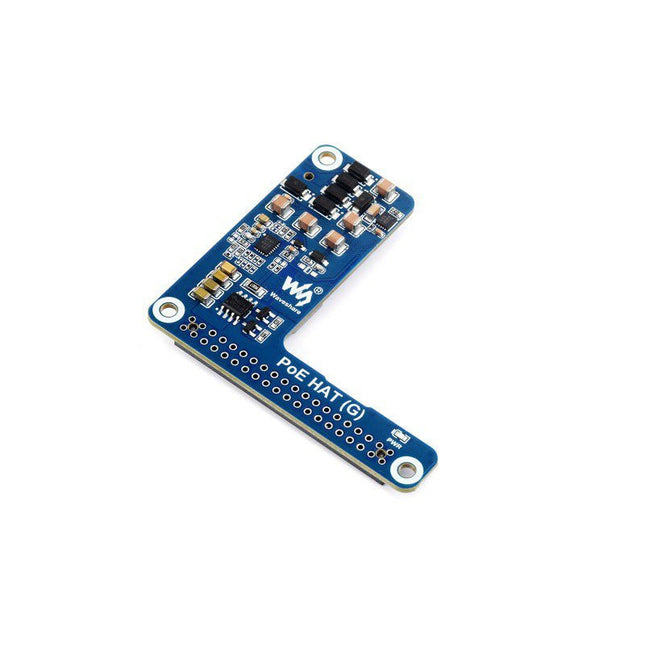
Waveshare Waveshare PoE HAT (G) for Raspberry Pi 5
The PoE HAT (G) is an IEEE 802.3af/at-compliant PoE (Power Over Ethernet) HAT for Raspberry Pi 5. By using with a PoE router or switch that supports the IEEE 802.3af/at network standard, it is possible to provide both network connection and power supply for your Raspberry Pi in only one Ethernet cable. Features Standard Raspberry Pi 40-pin GPIO header PoE capability, IEEE 802.3af/at-compliant Onboard original IC solution for more stable PoE power performance Adopts non-isolated switched-mode power supply (SMPS) Compact and easy to assemble Specifications PoE power input 38~57 V DC in Power output GPIO header: 5 V/5 A (max) Network standard IEEE 802.3af/at PoE Dimensions 56.5 x 64.98 mm Included 1x PoE HAT (G) 1x 2x2 header 1x 2x20 header 1x Standoffs pack Downloads Wiki
€ 24,95
Members € 22,46
-

Elektor Digital Arduino Uno – 45 Projects for Beginners and Experts (E-book)
This book covers a series of exciting and fun projects for the Arduino, such as a silent alarm, people sensor, light sensor, motor control, internet and wireless control (using a radio link). Contrary to many free projects on the internet all projects in this book have been extensively tested and are guaranteed to work! You can use it as a projects book and build more than 45 projects for your own use. The clear explanations, schematics, and pictures of each project make this a fun activity. The pictures are taken of a working project, so you know for sure that they are correct. You can combine the projects in this book to make your own projects. To facilitate this, clear explanations are provided on how the project works and why it has been designed the way it has That way you will learn a lot about the project and the parts used, knowledge that you can use in your own projects. Apart from that, the book can be used as a reference guide. Using the index, you can easily locate projects that serve as examples for the C++ commands and Arduino functionality. Even after you’ve built all the projects in this book, it will still be a valuable reference guide to keep next to your PC.
€ 29,95
Members € 23,96
-
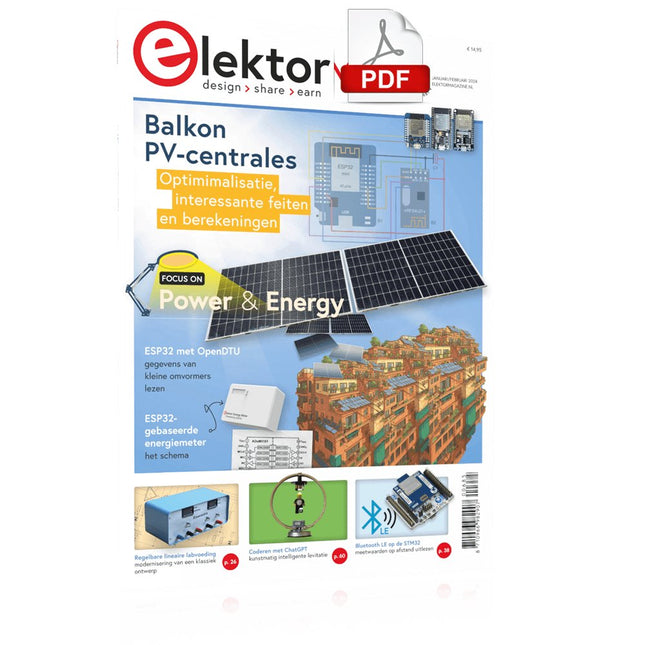
Elektor Digital Elektor Januari/Februari 2024 (PDF)
Elektor GREEN en GOLD leden kunnen deze uitgave hier downloaden. Nog geen lid? Klik hier om een lidmaatschap af te sluiten. Project-update: ESP32-gebaseerde energiemeterwe gaan verder met het prototype Optimalisatie van balkon PV-centralesoverwegingen, interessante feiten en berekeningen ESP32 met OpenDTU voor balkoncentralesgegevens van kleine omvormers via MCU’s uitlezen Regelbare lineaire labvoeding0...50 V / 0...2 A + dubbele symmetrische voeding Energieopslag – vandaag en morgeneen vraaggesprek met Simon Engelke 2024: een AI-odysseehet houdt nog lang niet op Bluetooth LE op de STM32meetwaarden op afstand uitlezen Mensvriendelijk slim keuken-voorraadsysteem MAUI: programmeren voor PC, tablet en smartphonehet nieuwe framework in theorie en praktijk ChatMagLevkunstmatig intelligente levitatie Eenvoudige PV-regelaarbouw je eerste, volledig functionele PV-energiebeheersysteem Koude-kathode-buizenvreemde onderdelen Uit het leven gegrepennostalgie Alle begin......bekijkt de FET CAN-bus voor de Arduino UNO R4: een tutorialtwee UNO R4’s nemen de bus! Elektor infographicvoeding en energie Vergelijking van vermogensdichtheid en vermogensefficiëntie Aluminium elektrolytische condensatorenstoringspotentieel in audiotechnologie USB testen en metenmet de Fnirsi FNB58 De Pixel Pump pick&place-tooleenvoudiger handmatige assemblage van SMT-printen Oost West Lab Bestnog niet zo lang geleden, in een land heel ver van hier... “In de wereld van ethiek in elektronica kunnen zelfs kleine stappen een aanzienlijke invloed hebben.” Ethiek in elektronicade OECD Guidelines en het Lieferkettensorgfaltspflichtengesetz Chadèche: slimme NiMH-(ont)laderlezersproject in het kort Project 2.0correcties, updates en brieven van lezers
€ 9,95
-

Luckfox LuckFox Pico Mini B Linux Micro Development Board (with Headers)
LuckFox Pico Mini is a compact Linux micro development board based on the Rockchip RV1103 chip, providing a simple and efficient development platform for developers. It supports a variety of interfaces, including MIPI CSI, GPIO, UART, SPI, I²C, USB, etc., which is convenient for quick development and debugging. Features Single-core ARM Cortex-A7 32-bit core with integrated NEON and FPU Built-in Rockchip self-developed 4th generation NPU, features high computing precision and supports int, int8, and int16 hybrid quantization. The computing power of int8 is 0.5 TOPS, and up to 1.0 TOPS with int4 Built-in self-developed third-generation ISP3.2, supports 4-Megapixel, with multiple image enhancement and correction algorithms such as HDR, WDR, multi-level noise reduction, etc. Features powerful encoding performance, supports intelligent encoding mode and adaptive stream saving according to the scene, saves more than 50% bit rate of the conventional CBR mode so that the images from camera are high-definition with smaller size, double the storage space Built-in RISC-V MCU supports low power consumption and fast start-up, supports 250 ms fast picture capture and loading Al model library at the same time to realize face recognition "in one second" Built-in 16-bit DRAM DDR2, which is capable of sustaining demanding memory bandwidths Integrated with built-in POR, audio codec and MAC PHY Specifications Processor ARM Cortex-A7, single-core 32-bit CPU, 1.2 GHz, with NEON and FPU NPU Rockchip 4th-gen NPU, supports int4, int8, int16; up to 1.0 TOPS (int4) ISP Third-gen ISP3.2, up to 4 MP input at 30fps, HDR, WDR, noise reduction RAM 64 MB DDR2 Storage 128 MB SPI NAND Flash USB USB 2.0 Host/Device via Type-C Camera Interface MIPI CSI 2-lane GPIO Pins 17 GPIO pins Power Consumption Low power, RISC-V MCU for fast startup Dimensions 28 x 21 mm Downloads Wiki
€ 19,95€ 9,95
Members identical
-
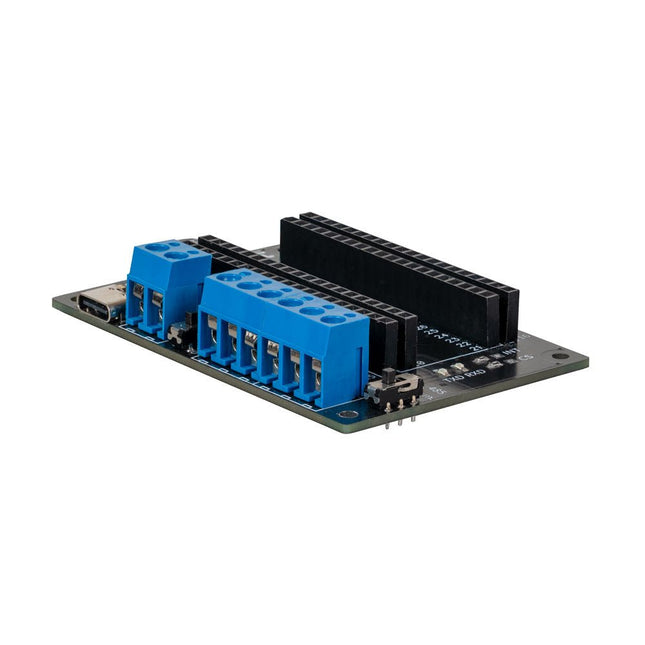
JOY-iT JOY-iT Expansion Board with CAN and RS485 Interface for Raspberry Pi Pico
This expansion board allows you to add an RS485 and a CAN interface to a Raspberry Pi Pico. The board also offers the option of operating it either via a standard USB-C connection with 5 V or via a screw terminal that accepts a voltage of 6 to 12 V. The voltage applied to the screw terminal is reduced to 5 V by a voltage converter integrated on the board. Features Power can be supplied via a USB-C connection with 5 V or via a screw terminal that draws between 6 and 12 V. In the latter case, a built-in voltage converter reduces the voltage to 5 V. To increase the versatility and range of functions, the connection pins of the Raspberry Pi Pico have been routed to the outside. The expansion board also offers the option of communication via the RS485 and CAN interfaces. Specifications CAN Interface SPI, CAN RS485 Interface Serial, RS485 Power supply 5 V DC (USB-C) Screw terminal 6-12 V DC Logic level 3.3 V Terminating resistor CAN 120 Ω (can be activated and deactivated as required) Terminating resistor RS485 120 Ω (can be activated and deactivated as required)
€ 14,95
Members € 13,46
-

ATETOOL T80-C Soldering Tip for Soldering Station AE970D
T80-C (T80-D16) Soldering Tip for Soldering Station AE970D (1.6 mm, chisel)
€ 9,95
Members € 8,96
-
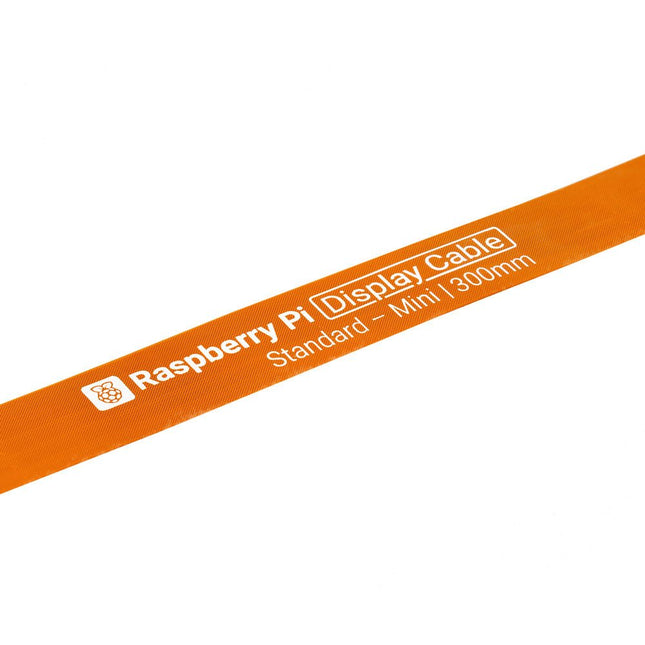
Raspberry Pi Foundation FPC Display Cable for Raspberry Pi 5 (300 mm)
Raspberry Pi 5 provides two four-lane MIPI connectors, each of which can support either a camera or a display. These connectors use the same 22-way, 0.5 mm-pitch “mini” FPC format as the Compute Module Development Kit, and require adapter cables to connect to the 15-way, 1 mm-pitch “standard” format connectors on current Raspbery Pi camera and display products.These mini-to-standard adapter cables for cameras and displays (note that a camera cable should not be used with a display, and vice versa) are available in 200 mm, 300 mm and 500 mm lengths.
€ 2,95
Members identical
-

WIZnet WIZnet W6100-EVB-Pico
W6100-EVB-Pico is a microcontroller evaluation board based on the Raspberry Pi RP2040 and fully hardwired TCP/IP controller W6100 – and basically works the same as Raspberry Pi Pico board but with additional Ethernet via W6100. Features RP2040 microcontroller with 2 MByte Flash Dual-core cortex M0+ at up to 133 MHz 264 kByte multi-bank high performance SRAM External Quad-SPI Flash with eXecute In Place (XIP) High performance full-crossbar bus fabric 30 multi-function General Purpose I/O (4 can be used for ADC) 1.8-3.3 V I/O voltage (Note: Pico I/O voltage is fixed at 3.3 V) 12-bit 500 ksps Analogue to Digital Converter (ADC) Various digital peripherals 2x UART, 2x I²C, 2x SPI, 16x PWM channels 1x Timer with 4 alarms, 1x Real Time Counter 2x Programmable IO (PIO) blocks, 8 state machines total Flexible, user-programmable high-speed I/O Can emulate interfaces such as SD card and VGA Includes W6100 Supports Hardwired Internet Protocols: TCP, UDP, IPv6, IPv4, ICMPv6, ICMPv4, IGMP, MLDv1, ARP, PPPoE Supports 8 independent SOCKETs simultaneously with 32 KB memory Internal 16 Kbytes Memory for TX/RX Buffers SPI Interface Micro-USB B port for power and data (and for reprogramming the Flash) 40-pin 21x51 ‘DIP’ style 1 mm thick PCB with 0.1' through-hole pins also with edge castellations 3-pin ARM Serial Wire Debug (SWD) port 10 / 100 Ethernet PHY embedded Supports Auto Negotiation Full / Half Duplex 10 / 100 Based Built-in RJ45 (RB1-125BAG1A) Built-in LDO (LM8805SF5-33V) Downloads Documents Getting started on GitHub Firmware
€ 21,95
Members € 19,76
-
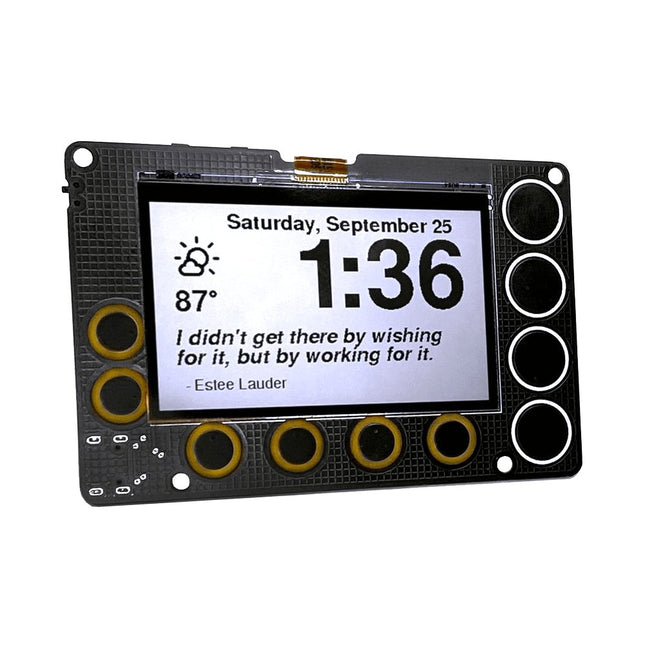
Phambili Phambili Newt 2.7" IoT Display (powered by ESP32-S2)
A low-power, open source, 2.7-inch IoT display powered by an ESP32-S2 module and featuring SHARP's Memory-in-Pixel (MiP) screen technology The Newt is a battery-powered, always-on, wall-mountable display that can go online to retrieve weather, calendars, sports scores, to-do lists, quotes…really anything on the Internet! It is powered by an ESP32-S2 microcontroller that you can program with Arduino, CircuitPython, MicroPython, or ESP-IDF. It's perfect for makers: Sharp’s Memory-in-Pixel (MiP) technology avoids the slow refresh times associated with E-Ink displays A real-time clock (RTC) was added to support timers and alarms The Newt was designed with battery operation in mind; every component on the board was chosen for its ability to operate at low power. Newt was designed to operate 'untethered,' which means it can be mounted in places where a power cord would be inconvenient, for example a wall, refrigerator, mirror, or dry-erase board. With the optional stand, desks, shelves, and nightstands are also good options. Newt is open source, and all design files and libraries are available for review, use, and modification. However, doing that is not required. Each Newt is delivered with working code with the following features: Current weather details Hourly and daily weather forecast Alarm Timer Inspirational quotes Air-quality forecast Habit calendar Pomodoro timer Oblique Strategy cards Only following the Wi-Fi provisioning instructions is needed to get started. No app downloads are required. Specifications Display Sharp Memory LCD Screen Size 2.7 inch Resolution 240 x 400 Deep Sleep Current 30 uA Refresh Rate < 0.001 s Periodic Screen Refresh Required No Input Buttons 10 capacitive pads, 1 push button RTC included Yes Speaker included Yes Power Input USB Type-C Battery included No Programming Languages Arduino, CircuitPython, ESP IDF, MicroPython Dimensions 91 x 61 x 9 mm Microcontroller Espressif ESP32-S2-WROVER Module with 4 MB flash and 2 MB PSRAM Wi-Fi capable Supports Arduino, MicroPython, CircuitPython, and ESP-IDF Deep sleep current as low as 25 μA Display 2.7-inch, 240 x 400 pixel MiP LCD Capable of delivering high-contrast, high-resolution, low-latency content with ultra-low power consumption Reflective mode leverages ambient light to eliminate the need for a backlight Time Keeping, Timers, and Alarms Micro Crystal RV-3028-C7 RTC Optimized for extreme low-power consumption (45 μA) Able to simultaneously manage a periodic timer, a countdown timer, and an alarm Hardware interrupt for timers and alarms 43 bytes of non-volatile user memory, 2 bytes of user RAM Separate UNIX time counter Buzzer Speaker/buzzer with mini class-D amplifier on DAC output A0 can play tones or lo-fi audio clips User Input Power switch Two programmable tactile buttons for Reset and Boot 10 capacitive touchpads Power Newt is designed to operate for one to two months between charges using a 500 mAH LiPo battery. The exact run time varies. (Heavy Wi-Fi use, in particular, will reduce battery charge more quickly.) USB Type-C connector for programming, power, and charging Low-quiescence voltage regulator (TOREX XC6220) that can output 1 A of current and operate as low as 8 μA. JST connector for a Lithium-Ion battery Battery-charging circuity (MCP73831) Low-battery indicator (1 μA quiescence current) Software Newt hardware is compatible with open-source Arduino libraries for ESP32-S2, Adafruit GFX (fonts), Adafruit Sharp Memory Display (display writing), and RTC RV-3028-C7 (RTC) Arduino libraries and sample programs are under development and will be available in our GitHub repository before launch CircuitPython libraries and registration are on the roadmap, with the development of a CircuitPython library for the RV-3028 real-time clock as a key dependency Included Phambili Newt – Fully assembled with pre-loaded firmware Laser-cut desktop stand Mini-magnet feet Required screws Support & Documentation Full instructions for use GitHub: Arduino Library and Codebase GitHub: Board schematics Videos of prototypes or demos (build tracked on Hackaday)
€ 144,95€ 109,95
Members identical
-
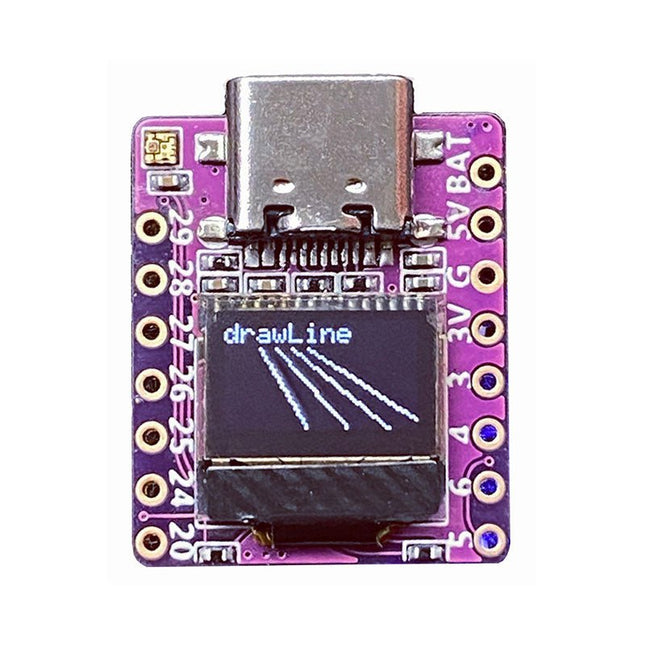
01Space 01Space RP2040-0.42LCD Development Board
Arduino, MicroPython, and CircuitPython-compatible compact development board powered by Raspberry Pi RP2040 RP2040-0.42LCD is a high-performance development board with integrated 0.42" LCD (70x40 resolution) with flexible digital interfaces. It incorporates Raspberry Pi's RP2040 microcontroller chip. The RP2040 features a dual-core Arm Cortex-M0+ processor clocked at 133 MHz with 264 KB internal SRAM and 2 MB flash storage. Specifications SoC Raspberry Pi RP2040 dual-core Cortex-M0+ microcontroller at up to 125 MHz, with 264 KB SRAM Storage 2 MB SPI flash Display 0.42-inch OLED USB 1x USB Type-C port for power and programming Expansion – Qwiic I²C connector– 7-pin and 8-pin headers with up to 11x GPIOs, 2x SPI, 2x I²C, 4x ADC, 1x UART, 5 V, 3.3 V, VBAT, GND Misc – Reset and Boot buttons– RGB LED, power LED Power supply – 5 V via USB-C port or Vin– VBAT pin for battery input– 3.3 V regulator with 500 mA peak output Dimensions 23.5 x 18 mm Weight 2.5 g Downloads GitHub
€ 19,95
Members € 17,96
-
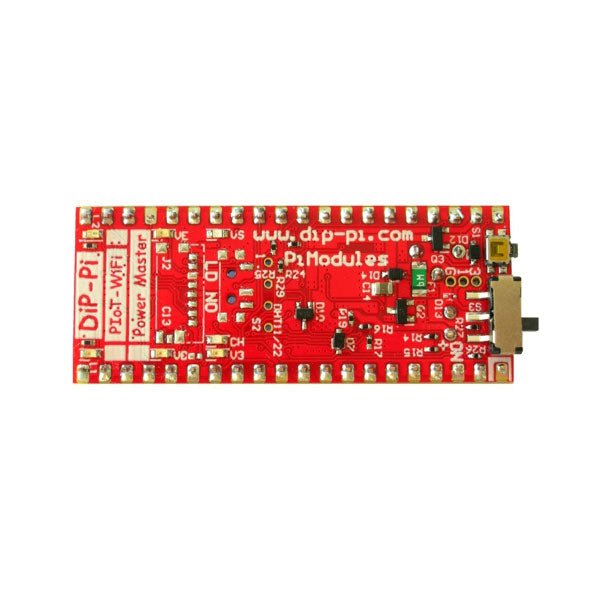
Pi Modules DiP-Pi Pico Power Master for Raspberry Pi Pico
The DiP-Pi Power Master is an Advanced Powering System with embedded sensors interfaces that cover most of possible needs for application based on Raspberry Pi Pico. It can supply the system with up to 1.5 A @ 4.8 V delivered from 6-18 VDC on various powering schemes like Cars, Industrial plant etc., additionally to original micro-USB of the Raspberry Pi Pico. It supports LiPo or Li-Ion Battery with Automatic Charger as also automatic switching from cable powering to battery powering or reverse (UPS functionality) when cable powering lost. Extended Powering Source (EPR) is protected with PPTC Resettable fuse, Reverse Polarity, as also ESD. The DiP-Pi Power Master contains Raspberry Pi Pico embedded RESET button as also ON/OFF Slide Switch that is acting on all powering sources (USB, EPR or Battery). User can monitor (via Raspberry Pi Pico A/D pins) battery level and EPR Level with PICO’s A/D converters. Both A/D inputs are bridged with 0402 resistors (0 OHM) therefore if for any reason user needs to use those Pico pins for their own application can be easy removed. The charger is automatically charging connected battery (if used) but in addition user can switch charger ON/OFF if their application needs it. DiP-Pi Power Master can be used for cable powered systems, but also for pure Battery Powered System with ON/OFF. Each powering source status is indicated by separate informative LEDs (VBUS, VSYS, VEPR, CHGR, V3V3). User can use any capacity of LiPo or Li-Ion type; however, must take care to use PCB protected batteries with max discharge current allowed of 2 A. The embedded battery charger is set to charge battery with 240 mA current. This current is set by resistor so if user need more/less can himself to change it. In Addition to all above features DiP-Pi Power Master is equipped with embedded 1-wire and DHT11/22 sensors interfaces. Combination of the extended powering, battery, and sensors interfaces make the DiP-Pi Power Master ideal for applications like data logger, plants monitoring, refrigerators monitoring etc. DiP-Pi Power Master is supported with plenty of ready to use examples written in Micro Python or C/C++. Specifications General Dimensions 21 x 51 mm Raspberry Pi Pico pinout compatible Independent Informative LEDs (VBUS, VSYS, VEPR, CHGR, V3V3) Raspberry Pi Pico RESET Button ON/OFF Slide Switch acting on all powering sources (USB, EPR, Battery) External Powering 6-18 V DC (Cars, Industrial Applications etc.) External Power (6-18 VDC) Level Monitoring Battery Level Monitoring Inverse Polarity Protection PPTC Fuse Protection ESD Protection Automatic Battery Charger (for PCB protected LiPo, Li-Ion – 2 A Max) Automatic/User Control Automatic Switch from Cable Powering to Battery Powering and reverse (UPS Functionality) Various powering schemes can be used at the same time with USB Powering, External Powering and Battery Powering 1.5 A @ 4.8 V Buck Converter on EPR Embedded 3.3 V @ 600mA LDO Embedded 1-wire Interface Embedded DHT-11/22 Interface Powering Options Raspberry Pi Pico micro-USB (via VBUS) External Powering 6-18 V (via dedicated Socket – 3.4/1.3 mm) External Battery Supported Battery Types LiPo with protection PCB max current 2A Li-Ion with protection PCB max current 2A Embedded Peripherals and Interfaces Embedded 1-wire interface Embedded DHT-11/22 Interface Programmer Interface Standard Raspberry Pi Pico C/C++ Standard Raspberry Pi Pico Micro Python Case Compatibility DiP-Pi Plexi-Cut Case System Monitoring Battery Level via Raspberry Pi Pico ADC0 (GP26) EPR Level via Raspberry Pi Pico ADC1 (GP27) Informative LEDs VB (VUSB) VS (VSYS) VE (VEPR) CH (VCHR) V3 (V3V3) System Protection Direct Raspberry Pi Pico Hardware Reset Button ESD Protection on EPR Reverse Polarity Protection on EPR PPTC 500 mA @ 18 V fuse on EPR EPR/LDO Over Temperature protection EPR/LDO Over Current protection System Design Designed and Simulated with PDA Analyzer with one of the most advanced CAD/CAM Tools – Altium Designer Industrial Originated PCB Construction 2 ozcopper PCB manufactured for proper high current supply and cooling 6 mils track/6 mils gap technology 2 layers PCB PCB Surface Finishing – Immersion Gold Multi-layer Copper Thermal Pipes for increased System Thermal Response and better passive cooling Downloads Datasheet Datasheet
€ 17,95€ 12,95
Members identical
-

FeeTech FeeTech FS90 Micro Servo with Accessories
Specifications Size 23.2 x 12.5 x 22 mm Weight 9 g Gear type Plastic Gear (Nylon & POM) Limit angle 120 Bearing No Ball bearings Horn gear spline 20T (4.8 mm) Horn type Plastic, POM Case Nylon & Fiberglass Connector wire 200 mm Motor Metal brush motor Spalsh water resistance No Included 1x FeeTech FS90 Servo 1x Straight single ended servo horn 1x Straight double ended servo horn 1x Winged straight double ended servo horn 1x Four-pointed star servo horn 1x Round servo horn 1x Servo horn screw 2x FS90 servo mounting screws Downloads User Guide
€ 12,95
Members € 11,66
-
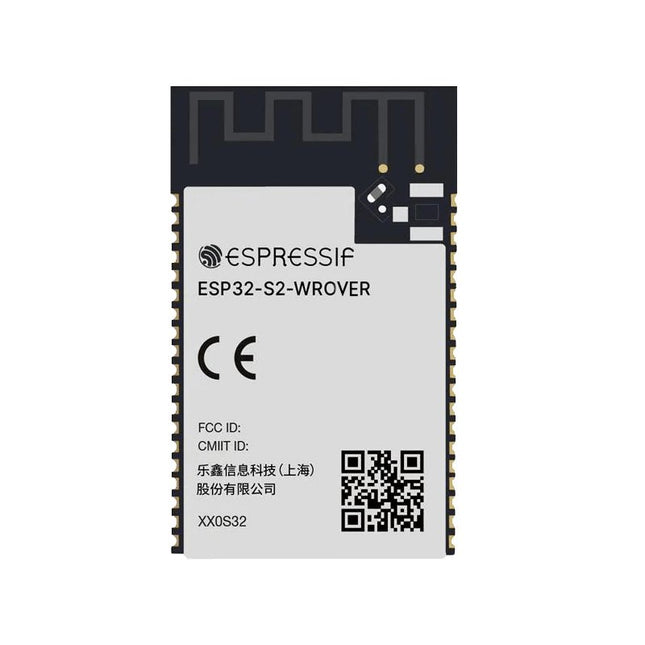
Espressif ESP32-S2-WROVER
At the core of this module is ESP32-S2, an Xtensa® 32-bit LX7 CPU that operates at up to 240 MHz. The chip has a low-power co-processor that can be used instead of the CPU to save power while performing tasks that do not require much computing power, such as monitoring of peripherals. ESP32-S2 integrates a rich set of peripherals, ranging from SPI, I²S, UART, I²C, LED PWM, TWAITM, LCD, Camera interface, ADC, DAC, touch sensor, temperature sensor, as well as up to 43 GPIOs. It also includes a full-speed USB On-The-Go (OTG) interface to enable USB communication.FeaturesMCU ESP32-S2 embedded, Xtensa® single-core 32-bit LX7 microprocessor, up to 240 MHz 128 KB ROM 320 KB SRAM 16 KB SRAM in RTC WiFi 802.11 b/g/n Bit rate: 802.11n up to 150 Mbps A-MPDU and A-MSDU aggregation 0.4 µs guard interval support Center frequency range of operating channel: 2412 ~ 2484 MHz Hardware Interfaces: GPIO, SPI, LCD, UART, I²C, I²S, Camera interface, IR, pulse counter, LED PWM, TWAI (compatible with ISO 11898-1), USB OTG 1.1, ADC, DAC, touch sensor, temperature sensor 40 MHz crystal oscillator 4 MB SPI flash Operating voltage/Power supply: 3.0 ~ 3.6 V Operating temperature range: –40 ~ 85 °C Dimensions: 18 × 31 × 3.3 mm Applications Generic Low-power IoT Sensor Hub Generic Low-power IoT Data Loggers Cameras for Video Streaming Over-the-top (OTT) Devices USB Devices Speech Recognition Image Recognition Mesh Network Home Automation Smart Home Control Panel Smart Building Industrial Automation Smart Agriculture Audio Applications Health Care Applications Wi-Fi-enabled Toys Wearable Electronics Retail & Catering Applications Smart POS Machines
€ 7,95
Members € 7,16
-
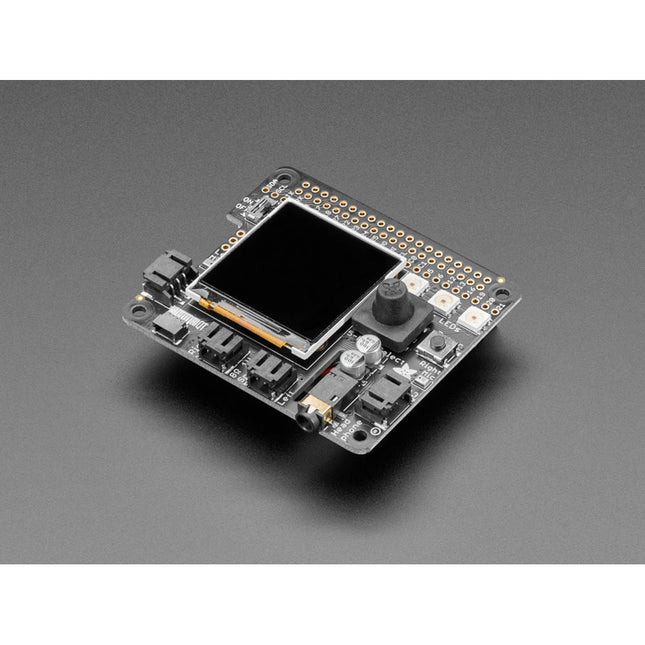
Adafruit Adafruit BrainCraft HAT – Machine Learning for Raspberry Pi 4
Features 1.54" IPS TFT display with 240x240 resolution that can show text or video Stereo speaker ports for audio playback - either text-to-speech, alerts or for creating a voice assistant. Stereo headphone out for audio playback through a stereo system, headphones, or powered speakers. Stereo microphone input - perfect for making your very own smart home assistants Two 3-pin JST STEMMA connectors that can be used to connect more buttons, a relay, or even some NeoPixels! STEMMA QT plug-and-play I2C port can be used with any of Adafruits 50+ I2C STEMMA QT boards or can be used to connect to Grove I²C devices with an adapter cable. 5-Way Joystick + Button for user interface and control. Three RGB DotStar LEDs for colorful LED feedback. The STEMMA QT port means you can attach heat image sensors like the Panasonic Grid-EYE or MLX90640. Heat-Sensitive cameras can be used as a person detector, even in the dark! An external accelerometer can be attached for gesture or vibration sensing such as machinery/industrial predictive maintenance projects Please note: A Raspberry Pi 4 is not included.
€ 49,95€ 34,95
Members identical
-

SparkFun SparkFun Power Delivery Board - USB-C (Qwiic)
The Power Delivery Board uses a standalone controller to negotiate with the power adapters and switch to a higher voltage other than just 5V. This uses the same power adapter for different projects rather than relying on multiple power adapters to provide different output; it can deliver the board as part of SparkFun’s Qwiic connect system, so you won’t have to do any soldering to figure out how things are oriented. The SparkFun Power Delivery Board takes advantage of the power delivery standard using a standalone controller from STMicroelectronics, the STUSB4500. The STUSB4500 is a USB power delivery controller that addresses sink devices. It implements a proprietary algorithm to negotiate a power delivery contract with a source (i.e. a power delivery wall wart or power adapter) without the need for an external microcontroller. However, you will need a microcontroller to configure the board. PDO profiles are configured in an integrated non-volatile memory. The controller does all the heavy lifting of power negotiation and provides an easy way to configure over I²C. To configure the board, you will need an I²C bus. The Qwiic system makes it easy to connect the Power Delivery board to a microcontroller. Depending on your application, you can also connect to the I²C bus via the plated through SDA and SCL holes. Features Input and output voltage range of 5-20V Output current up to 5A Three configurable power delivery profiles Auto-run Type-C™ and USB PD sink controller Certified USB Type-C™ rev 1.2 and USB PD rev 2.0 (TID #1000133) Integrated VBUS voltage monitoring Integrated VBUS switch gate drivers (PMOS)
€ 34,95€ 24,95
Members identical
-
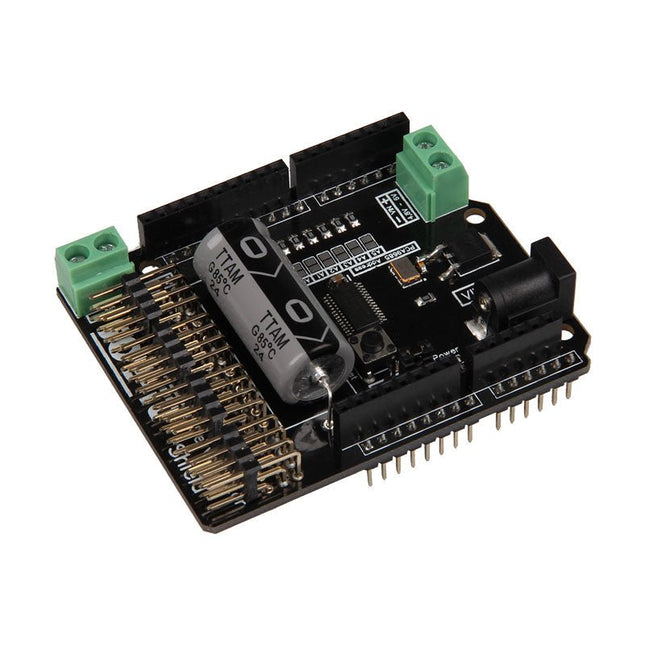
JOY-iT JOY-iT Motorino - Motor Control for Arduino
The Motorino board is an extension-board to control and use up to 16 PWM-controlled 5V-Servo-motors. The included clock generator ensures a very precise PWM signal and a very precise positioning. The board has 2 inputs for voltage from 4.8 V to 6 V which can be used for up to 11 A. With this input, a perfect power supply is always guaranteed and even bigger projects are no problem. The supply runs directly over the Motorino which provides a connection for voltage, ground and control. With the build in capacitor, the voltage is buffered which prevents a sudden voltage-drop at a high load. But there is also the possibility to connect another capacitor. The control and the programing can be done, as usual, with the Arduino. Manuals and code examples allows a quick introduction for beginners. Special features 16 Channels, own clock generator Input 1 Coaxial power connector 5.5 / 2.1 mm, 4.8-6 V / 5 A max Input 2 Screw-terminal, 4.8-6 V / 6 A max Communication 16 x PWM Compatible with Arduino Uno, Mega and may more microcontroller with Arduino compatible pinout Dimensions 69 x 24 x 56 mm Scope of supply Board, Manual, Retail package
€ 26,95
Members € 24,26
-
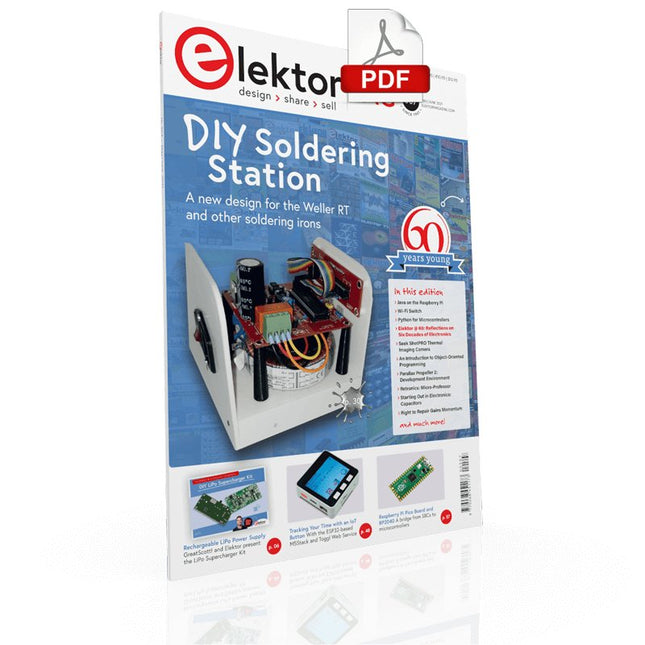
Elektor Digital Elektor May/June 2021 (PDF)
Elektor Magazine EN May/June 2021 (PDF)
€ 7,50
-
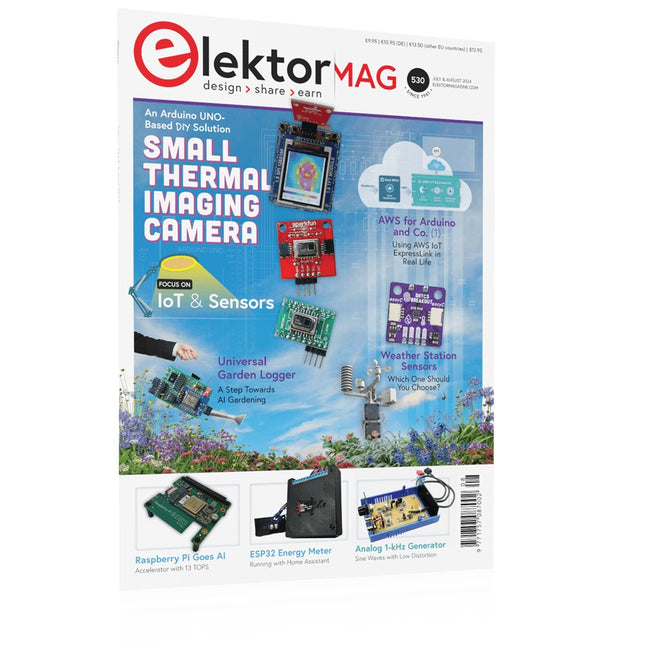
Elektor July/August 2024
Elektor GREEN and GOLD members can download their digital edition here. Not a member yet? Click here. Small Thermal Imaging CameraAn Arduino UNO-Based DIY Solution Project Update #3: ESP32-Based Energy MeterIntegration and Testing with Home Assistant 2024: An AI OdysseyEnhancing Object Detection: Integrating Refined Techniques Raspberry Pi Goes AINew Kit Incorporates M.2 HAT+ With AI Accelerator Weather Station SensorsWhich One Should You Choose? AI-Based Water Meter Reading (1)Get Your Old Meter Onto the IoT! A GSM AlarmHarnessing GSM Technology for Remote Garage Safety Low-Power Thread Devices Optimized and ScrutinizedLow Power … Low Effort? From Life’s ExperienceThe Gender Gap DIY Cloud ChamberMaking Invisible Radiation Visible SparkFun Thing Plus MatterA Versatile Matter-Based IoT Development Board IoT RetrofittingMaking RS-232 Devices Fit for Industry 4.0 Enabling IoT with 8-Bit MCUs Technology Drives SustainabilityAdvances Lead to More Efficient Use of Energy in Many Applications AWS for Arduino and Co. (1)Using AWS IoT ExpressLink in Real Life Airflow Detector Using Arduino OnlyNo External Sensors Needed! Water Leak DetectorConnected to Arduino Cloud CrystalsPeculiar Parts, the Series Universal Garden LoggerA Step Towards AI Gardening Analog 1 kHz GeneratorSine Waves with Low Distortion Miletus: Using Web Apps OfflineSystem and Device Access Included! From 4G to 5GIs It Such an Easy Step? Starting Out in Electronics……Balances Out
€ 10,95
-

Raspberry Pi Foundation FPC Display Cable for Raspberry Pi 5 (500 mm)
Raspberry Pi 5 provides two four-lane MIPI connectors, each of which can support either a camera or a display. These connectors use the same 22-way, 0.5 mm-pitch “mini” FPC format as the Compute Module Development Kit, and require adapter cables to connect to the 15-way, 1 mm-pitch “standard” format connectors on current Raspbery Pi camera and display products.These mini-to-standard adapter cables for cameras and displays (note that a camera cable should not be used with a display, and vice versa) are available in 200 mm, 300 mm and 500 mm lengths.
€ 3,95
Members identical
-
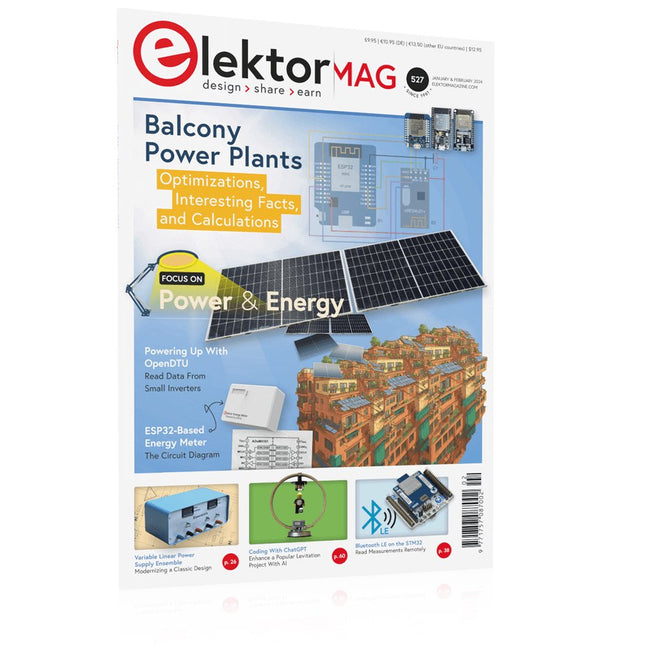
Elektor January/February 2024
Elektor GREEN and GOLD members can download their digital edition here. Not a member yet? Click here. Project Update: ESP32-Based Energy MeterNext Steps in Prototyping Optimizing Balcony Power PlantsConsiderations, Interesting Facts, and Calculations ESP32 With OpenDTU for Balcony Power PlantsRead Data from Small Inverters Via MCUs Variable Linear Power Supply Ensemble0…50 V / 0…2 A + Dual Symmetrical Supply Energy Storage Today and TomorrowAn Interview With Simon Engelke 2024: An AI OdysseyIt’s Not Letting Up Bluetooth LE on the STM32A Way to Read Measurements Remotely Human-Centric Smart Kitchen Grocery Container MAUI: Programming for PC, Tablet, and SmartphoneThe New Framework in Theory and Practice ChatMagLevThe AI Way of Levitation Simple PV Power RegulatorBuild Your First, Fully Functional PV Energy Management System Cold-Cathode DevicesPeculiar Parts, the Series From Life’s ExperienceNostalgia Starting Out in Electronics……Looking at FETs CAN Bus Tutorial for the Arduino UNO R4Two UNO R4s Hop on the Bus! Infographics: Power & Energy Comprehensive Design and Development SupportArrow Engineering Services Comparing Power Density and Power Efficiency Aluminium Electrolytic CapacitorsInterference Potential in Audio Technology USB Test and MeasurementThe Fnirsi FNB58 The Pixel Pump Pick-and-Place ToolSimplifying Manual SMT Board Assembly HomeLab ToursNot So Long Ago, in a Far-Away Country... “In the world of ethics in electronics, even small steps can make a significant impact.” Ethics in ElectronicsThe OECD Guidelines and Germany’s Supply Chain Due Diligence Act Chadèche: Smart Ni-MH Charger/DischargerA Reader’s Project in Brief Err-lectronicsCorrections, Updates and Readers’ Letters
€ 10,95
-
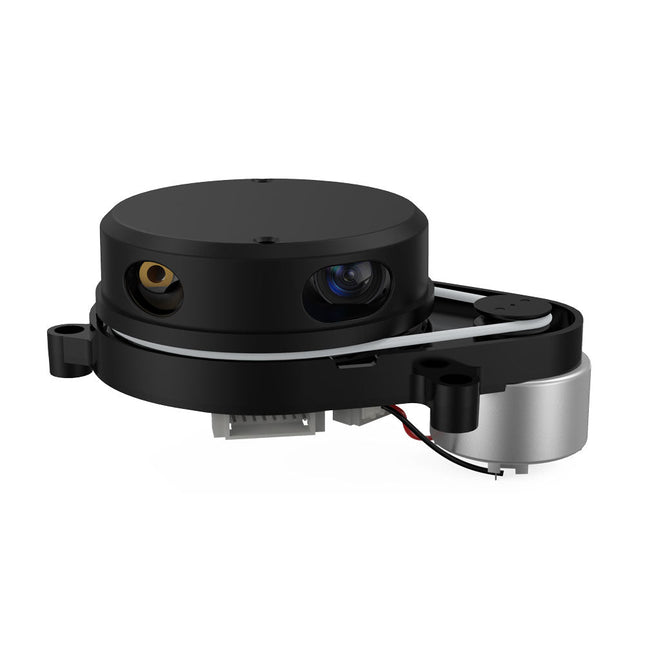
YDLIDAR YDLIDAR X4Pro Lidar – 360-degree Laser Range Scanner (10 m)
YDLIDAR X4PRO is a 360 degrees two-dimensional rangefinder. Based on the principle of triangulation, it is equipped with related optics, electricity, and algorithm design to achieve high-frequency and high- accuracy distance measurement. The mechanical structure rotates 360 degrees to continuously output the angle information as well as the point cloud data of the scanning environment while ranging. Features 360 degrees omnidirectional scanning ranging distance measurement Small distance error, stable performance and high accuracy Wide ranging distance Strong resistance to ambient light interference Low power consumption, small size and long service life Laser power meets Class I laser safety standards Adjustable motor speed, scanning frequency is 6~12 Hz High-speed ranging, ranging frequency up to 5 kHz Applications Robot navigation and obstacle avoidance Robot ROS teaching and research Regional security Environmental scanning and 3D reconstruction Navigation and obstacle avoidance of robot vacuum cleaner/ROS Learning robot Specifications Range Frequency 5000 Hz Scan Frequency 6-12 Hz Range Distance 0.12 10 m Scan Angle 360° Angle Resolution 0.43-0.85° Dimensions 110.6 x 71.1 x 52.3 mm Downloads Datasheet User Manual Development Manual SDK Tool ROS
€ 109,95€ 79,95
Members identical
-

Pimoroni Pimoroni Piano HAT for Raspberry Pi
Unlock your inner Mozart with Piano HAT, a mini musical companion for your Raspberry Pi! Piano HAT is inspired by Zachary Igielman's PiPiano and made with his blessing. It has taken his fabulous idea for a dinky piano add-on for the Raspberry Pi, made it touch-sensitive and added barrels of our trademark Pimoroni polish. Play music in Python, control software synths on your Pi, and take control of hardware synthesizers! Features 16 capacitive touch pads (link each to their own Python function!) 13 piano keys (a full octave) Octave up/down buttons Instrument cycle button (great for use with synthesizers) 16 bright white LEDs (let them light automagically, or take control with Python) 2x Microchip CAP1188 capacitive touch driver chips Use it to control software or hardware synths over MIDI Compatible with all 40-pin header Raspberry Pi models Comes fully assembled Downloads Python library Pinout
€ 29,95
Members € 26,96
-

SparkFun SparkFun Thing Plus Matter (MGM240P)
The SparkFun Thing Plus Matter is the first easily accessible board of its kind that combines Matter and SparkFun’s Qwiic ecosystem for agile development and prototyping of Matter-based IoT devices. The MGM240P wireless module from Silicon Labs provides secure connectivity for both 802.15.4 with Mesh communication (Thread) and Bluetooth Low Energy 5.3 protocols. The module comes ready for integration into Silicon Labs' Matter IoT protocol for home automation. What is Matter? Simply put, Matter allows for consistent operation between smart home devices and IoT platforms without an Internet connection, even from different providers. In doing so, Matter is able to communicate between major IoT ecosystems in order to create a single wireless protocol that is easy, reliable, and secure to use. The Thing Plus Matter (MGM240P) includes Qwiic and LiPo battery connectors, and multiple GPIO pins capable of complete multiplexing through software. The board also features the MCP73831 single-cell LiPo charger as well as the MAX17048 fuel gauge to charge and monitor a connected battery. Lastly, a µSD card slot for any external memory needs is integrated. The MGM240P wireless module is built around the EFR32MG24 Wireless SoC with a 32-bit ARM Cortext-M33 core processor running at 39 MHz with 1536 kb Flash memory and 256 kb RAM. The MGM240P works with common 802.15.4 wireless protocols (Matter, ZigBee, and OpenThread) as well as Bluetooth Low Energy 5.3. The MGM240P supports Silicon Labs' Secure Vault for Thread applications. Specifications MGM240P Wireless Module Built around the EFR32MG24 Wireless SoC 32-bit ARM-M33 Core Processor (@ 39 MHz) 1536 kB Flash Memory 256 kB RAM Supports Multiple 802.15.4 Wireless Protocols (ZigBee and OpenThread) Bluetooth Low Energy 5.3 Matter-ready Secure Vault Support Built-in Antenna Thing Plus Form-Factor (Feather-compatible): Dimensions: 5.8 x 2.3 cm (2.30 x 0.9') 2 Mounting Holes: 4-40 screw compatible 21 GPIO PTH Breakouts All pins have complete multiplexing capability through software SPI, I²C and UART interfaces mapped by default to labeled pins 13 GPIO (6 labeled as Analog, 7 labeled for GPIO) All function as either GPIO or Analog Built-in-Digital to Analog Converter (DAC) USB-C Connector 2-Pin JST LiPo Battery Connector for a LiPo Battery (not included) 4-Pin JST Qwiic Connector MC73831 Single-Cell LiPo Charger Configurable charge rate (500 mA Default, 100 mA Alternate) MAX17048 Single-Cell LiPo Fuel Gauge µSD Card Slot Low Power Consumption (15 µA when MGM240P is in Low Power Mode) LEDs: PWR – Red Power LED CHG – Yellow battery charging status LED STAT – Blue status LED Reset Button: Physical push-button Reset signal can be tied to A0 to enable use as a peripheral device Downloads Schematic Eagle Files Board Dimensions Hookup Guide Datasheet (MGM240P) Fritzing Part Thing+ Comparison Guide Qwiic Info Page GitHub Hardware Repo
€ 34,95€ 24,95
Members identical
-
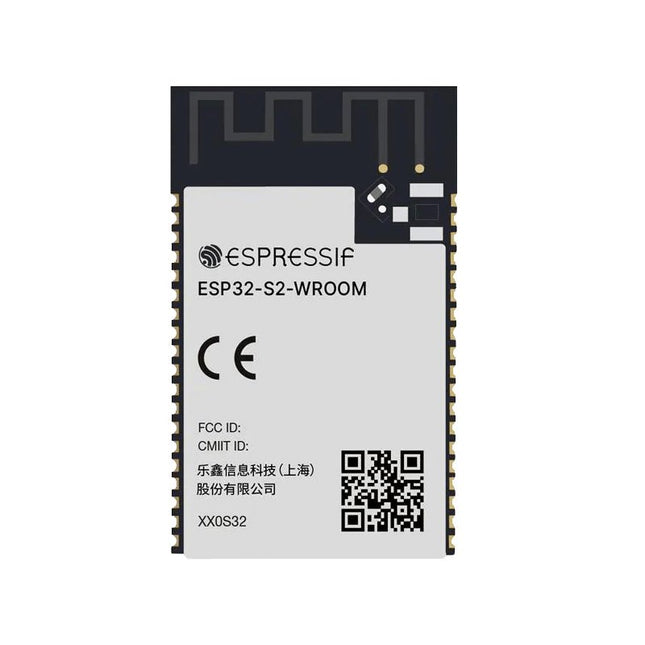
Espressif ESP32-S2-WROOM
At the core of this module is ESP32-S2, an Xtensa® 32-bit LX7 CPU that operates at up to 240 MHz. The chip has a low-power co-processor that can be used instead of the CPU to save power while performing tasks that do not require much computing power, such as monitoring of peripherals. ESP32-S2 integrates a rich set of peripherals, ranging from SPI, I²S, UART, I²C, LED PWM, TWAITM, LCD, Camera interface, ADC, DAC, touch sensor, temperature sensor, as well as up to 43 GPIOs. It also includes a full-speed USB On-The-Go (OTG) interface to enable USB communication.FeaturesMCU ESP32-S2 embedded, Xtensa® single-core 32-bit LX7 microprocessor, up to 240 MHz 128 KB ROM 320 KB SRAM 16 KB SRAM in RTC WiFi 802.11 b/g/n Bit rate: 802.11n up to 150 Mbps A-MPDU and A-MSDU aggregation 0.4 µs guard interval support Center frequency range of operating channel: 2412 ~ 2484 MHz Hardware Interfaces: GPIO, SPI, LCD, UART, I²C, I²S, Camera interface, IR, pulse counter, LED PWM, TWAI (compatible with ISO 11898-1), USB OTG 1.1, ADC, DAC, touch sensor, temperature sensor 40 MHz crystal oscillator 4 MB SPI flash Operating voltage/Power supply: 3.0 ~ 3.6 V Operating temperature range: –40 ~ 85 °C Dimensions: 18 × 31 × 3.3 mm Applications Generic Low-power IoT Sensor Hub Generic Low-power IoT Data Loggers Cameras for Video Streaming Over-the-top (OTT) Devices USB Devices Speech Recognition Image Recognition Mesh Network Home Automation Smart Home Control Panel Smart Building Industrial Automation Smart Agriculture Audio Applications Health Care Applications Wi-Fi-enabled Toys Wearable Electronics Retail & Catering Applications Smart POS Machines
€ 6,95
Members € 6,26























